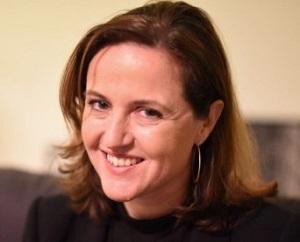In an increasingly global world, Americans should be adding, not slashing, opportunities for their children to learn another tongue.

de Montlaur image (not from article) from
Ms. de Montlaur is the cultural counselor of the French Embassy in the United States.
In January, the Modern Language Association made an astonishing announcement in The Chronicle of Higher Education: From 2013 to 2016, colleges across the United States cut 651 foreign language programs. French was the hardest hit, losing 129 programs, followed by Spanish with 118, German with 86 and Italian with 56. Once these programs close, they are very hard to reopen.
According to a Pew study from last year, only 20 percent of K-12 students in America study a foreign language (compared with an average of 92 percent in Europe), and only 10 states and the District of Columbia make foreign-language learning a high school graduation requirement.
The decline in language education could have devastating effects for generations to come. With fewer options for learning a foreign language in school, a sharp decrease in interest is likely to follow. According to the Modern Language Association, enrollment in college-level foreign-language courses dropped 9.2 percent from 2013 to 2016.
The association says these changes are most likely a direct result of the 2008 recession, which hit foreign-language degree programs harder than many other humanities programs. As programs shrink so does the supply of qualified teachers. It’s a vicious cycle.
And yet, knowing a foreign language is becoming ever more essential. The freshman congresswoman Alexandria Ocasio-Cortez, who is Spanish-English bilingual, recently tweeted, “Bilingualism is a huge advantage in the economy and the world.” Ms. Ocasio-Cortez, who at age 29 is already one of the best-known members of the Democratic Party, is a case in point.
Her sentiment is shared by many. In response, some educators and parents are rethinking the way language is taught and calling for expanded access to language education.
Nationwide, parents and teachers have been leading grass-roots initiatives to provide foreign-language learning in public schools, and some universities have instituted innovative language programs. From pre-K to graduate studies, there is a move toward holistic language education, based on the notion that learning a language should be grounded in the real, everyday use of that language.
Some universities have restructured programs to emphasize the ability to work, socialize and research across languages, offering dual degrees in which students’ language education is directly tied to its application in their other fields of study. Georgia Tech, for example, has devised programs aimed at developing language skills that allow them to work more effectively in, and to be more attractive to, international companies and organizations. The University of Rhode Island is offering a program “for students looking to become truly global engineers,” which combines a foreign language degree with one in engineering.
In public schools, parents have also pushed for dual-language immersion programs, which foster fluency for students who need help with English while allowing English speakers to gain a new language. In Anchorage, Alaska, the school board recently approved a French [JB comment :) -- not Russian?] dual-language program after a petition by parents. In New York, parent organizing has been instrumental in the opening of dual-language programs for decades.
In concert with these efforts, Mayor Bill de Blasio of New York announced last month that 47 more pre-K dual-language programs in city schools will open in the fall. In total, there will be 107 dual-language programs for the 2019-20 school year, including the city’s first French, Haitian-Creole, Hebrew and Japanese pre-K programs.
Elsewhere, Utah is aiming to internationalize its population by offering dual-language programs to English speakers; its International Education Initiative became law in 2008, and its public schools now offer about 200 immersion programs. “Global California 2030,” an initiative by the state’s superintendent of public education “to vastly expand the teaching and learning of world languages,” was recently adopted in part to maintain and strengthen the diversity of languages spoken in the state.
The French government has long played a role in the support of French language programs in the United States. French offers both great professional potential and access to the vast and growing Francophone community, which could reach 700 million by 2050.
As cultural counselor of the French Embassy, I have spearheaded the creation and development of the French Dual Language Fund, inaugurated by President Emmanuel Macron in 2017, which supports bilingual programs in public schools in the United States. The process of adding such programs varies enormously from one state to another, but the commitment of school districts is crucial for their development.
If Americans want the next generation to be active participants in a multilingual world, dual-language and multicultural education is crucial. Government spending on foreign-language education and the education of qualified foreign-language teachers needs to increase. More states need to enforce language-education requirements. Colleges need to recognize the importance of their foreign-language education programs. In turn, more parents, students and teachers need to lobby for language programs.
The necessity of foreign-language education could not be clearer right now. The future in America, and everywhere, is multilingual. And so is the present.
Bénédicte de Montlaur is the cultural counselor of the French Embassy in the United States.
No comments:
Post a Comment